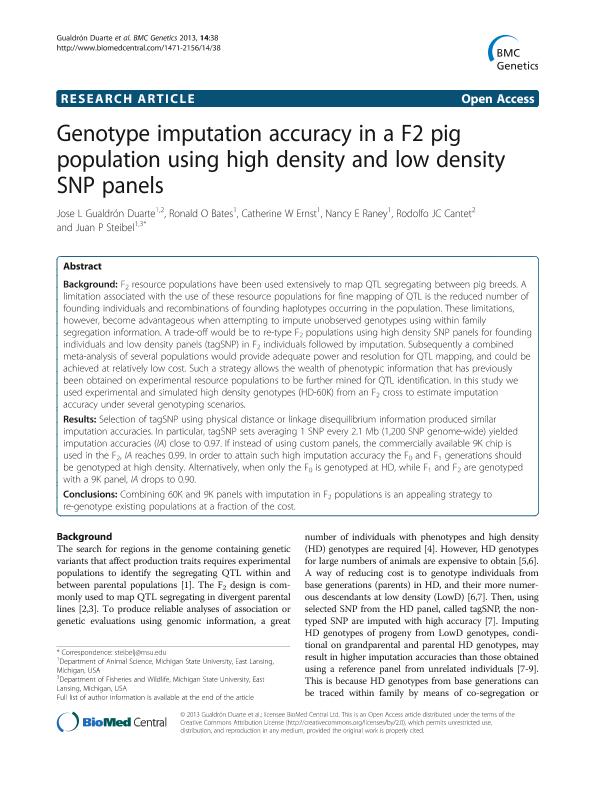Mostrar el registro sencillo del ítem
dc.contributor.author
Gualdron Duarte, Jose Luis

dc.contributor.author
Bates, Ronald O.
dc.contributor.author
Ernst, Catherine W.
dc.contributor.author
Raney, Nancy E.
dc.contributor.author
Cantet, Rodolfo Juan Carlos

dc.contributor.author
Steibel, Juan P.
dc.date.available
2017-10-06T20:56:51Z
dc.date.issued
2013-05
dc.identifier.citation
Gualdron Duarte, Jose Luis; Bates, Ronald O.; Ernst, Catherine W.; Raney, Nancy E.; Cantet, Rodolfo Juan Carlos; et al.; Genotype imputation accuracy in a F2 pig population using high density and low density SNP panels; BioMed Central; BMC Genetics; 14; 5-2013; 38-51
dc.identifier.issn
1471-2156
dc.identifier.uri
http://hdl.handle.net/11336/26192
dc.description.abstract
Background: F2 resource populations have been used extensively to map QTL segregating between pig breeds. A limitation associated with the use of these resource populations for fine mapping of QTL is the reduced number of founding individuals and recombinations of founding haplotypes occurring in the population. These limitations, however, become advantageous when attempting to impute unobserved genotypes using within family segregation information. A trade-off would be to re-type F2 populations using high density SNP panels for founding individuals and low density panels (tagSNP) in F2 individuals followed by imputation. Subsequently a combined meta-analysis of several populations would provide adequate power and resolution for QTL mapping, and could be achieved at relatively low cost. Such a strategy allows the wealth of phenotypic information that has previously been obtained on experimental resource populations to be further mined for QTL identification. In this study we used experimental and simulated high density genotypes (HD-60K) from an F2 cross to estimate imputation accuracy under several genotyping scenarios. Results: Selection of tagSNP using physical distance or linkage disequilibrium information produced similar imputation accuracies. In particular, tagSNP sets averaging 1 SNP every 2.1 Mb (1,200 SNP genome-wide) yielded imputation accuracies (IA) close to 0.97. If instead of using custom panels, the commercially available 9K chip is used in the F2, IA reaches 0.99. In order to attain such high imputation accuracy the F0 and F1 generations should be genotyped at high density. Alternatively, when only the F0 is genotyped at HD, while F1 and F2 are genotyped with a 9K panel, IA drops to 0.90. Conclusions: Combining 60K and 9K panels with imputation in F2 populations is an appealing strategy to re-genotype existing populations at a fraction of the cost.
dc.format
application/pdf
dc.language.iso
eng
dc.publisher
BioMed Central

dc.rights
info:eu-repo/semantics/openAccess
dc.rights.uri
https://creativecommons.org/licenses/by-nc-sa/2.5/ar/
dc.subject
Genotype Imputation
dc.subject
Tag Snps
dc.subject
Pigs
dc.subject.classification
Otras Producción Animal y Lechería

dc.subject.classification
Producción Animal y Lechería

dc.subject.classification
CIENCIAS AGRÍCOLAS

dc.title
Genotype imputation accuracy in a F2 pig population using high density and low density SNP panels
dc.type
info:eu-repo/semantics/article
dc.type
info:ar-repo/semantics/artículo
dc.type
info:eu-repo/semantics/publishedVersion
dc.date.updated
2017-08-25T19:53:28Z
dc.journal.volume
14
dc.journal.pagination
38-51
dc.journal.pais
Reino Unido

dc.journal.ciudad
Londres
dc.description.fil
Fil: Gualdron Duarte, Jose Luis. Michigan State University; Estados Unidos. Universidad de Buenos Aires. Facultad de Agronomia. Departamento de Producción Animal; Argentina. Consejo Nacional de Investigaciones Científicas y Técnicas; Argentina
dc.description.fil
Fil: Bates, Ronald O.. Michigan State University; Estados Unidos
dc.description.fil
Fil: Ernst, Catherine W.. Michigan State University; Estados Unidos
dc.description.fil
Fil: Raney, Nancy E.. Michigan State University; Estados Unidos
dc.description.fil
Fil: Cantet, Rodolfo Juan Carlos. Universidad de Buenos Aires. Facultad de Agronomia. Departamento de Producción Animal; Argentina. Consejo Nacional de Investigaciones Científicas y Técnicas; Argentina
dc.description.fil
Fil: Steibel, Juan P.. Michigan State University; Estados Unidos
dc.journal.title
BMC Genetics

dc.relation.alternativeid
info:eu-repo/semantics/altIdentifier/doi/http://dx.doi.org/10.1186/1471-2156-14-38
dc.relation.alternativeid
info:eu-repo/semantics/altIdentifier/url/https://bmcgenet.biomedcentral.com/articles/10.1186/1471-2156-14-38
Archivos asociados
